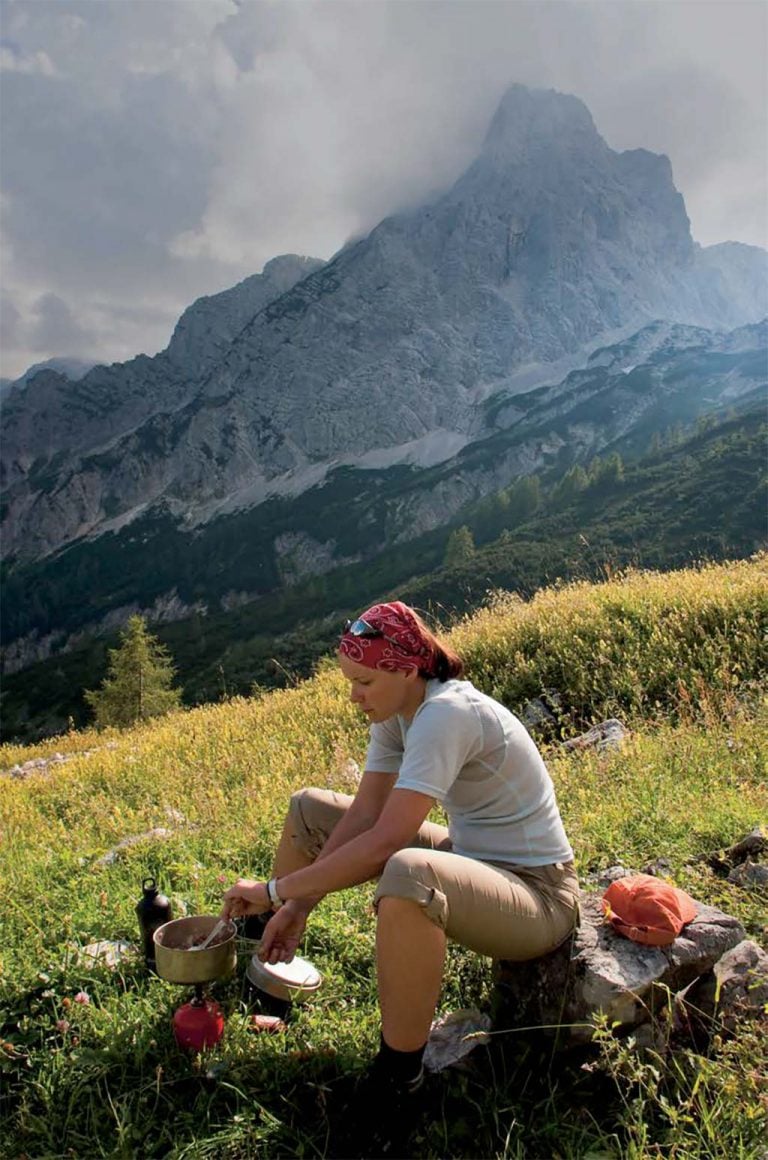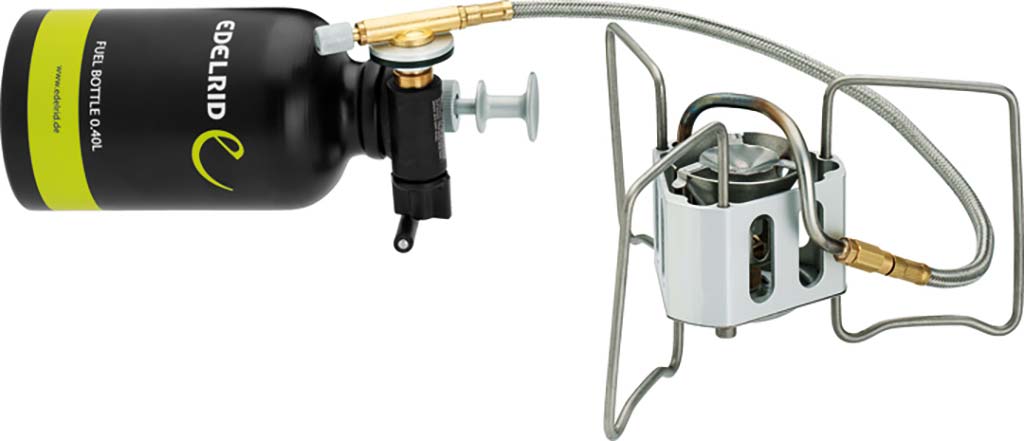Alun Davies is on the boil – he’s working out which camping stoves are best for your next bike trip
After a hard day in the saddle, the tent’s up and your gear’s unpacked. It’s time to fire up that camping stove and party – but which stove? In days of old, cooking at the campsite was stress free and plain sailing. Dining out in the great outdoors meant collecting a pile of dead wood, striking a flint and roasting a mammoth or two. These days it’s a lot more complicated and usually kicks off with a severe bout of information anxiety in the gear shop, deciding which is the best stove for you out of the multitude on offer. From multifuel to solar-powered the choice is legion and all have their strengths and weaknesses. And, as no one stove has it all, cooker selection can be a difficult and frustrating experience culminating in the realisation that you’re going to have to compromise.
Stove/fuel types
Although there are other forms of fuel in use, for all practical purposes camping stoves come under three general headings: gas, petroleum and alcohol.
Liquefied gas stoves (propane, butane, isobutane)
If you want a stove that works like your gas cooker at home then liquefied gas is the way to go. In use they are no fuss, adjusting from a light simmer to full-on boil mode with the turn of a knob. A big plus with gas stoves is that they are clean in operation. On the downside the gas canisters are expensive and may not work in below-freezing temperatures. If your travels are within Europe then a liquefied gas stove is the cheapest, most convenient and best overall choice. However, canisters come with different fitments and finding the right one for your stove can be a problem. We’ve been known to buy cheap stoves locally in Portugal, Austria and Greece when we couldn’t find canisters to fit the stove in our panniers.
Petroleum stoves (aka multi-fuel stoves)
If your two-wheeled travels are taking you outside of Europe, where gas availability isn’t guaranteed, then a multi-fuel stove’s a good option. Multi-fuel stoves, as the name suggests, burn just about anything, from parafin (kerosene/diesel) to leaded and unleaded petrol. If there’s any chance you’ll be burning vehicle fuel then you’ll need to take into account the proven reliability of the stove, as well as its ease of cleaning and maintenance. The safest fuels to use are Naphtha products such as Coleman fuel and MSR fuel, which are less explosive than ‘petrol’ products. Just so you know, people die each year using volatile liquids in multifuel stoves and all petroleum-based fuels are toxic and dangerous, some more so than others.
Alcohol stoves (methylated spirits)
Many overland adventurers will tell you that the best stove for travelling in Africa and out-of-the-way destinations is an uncomplicated meths-based stove. These stoves are of a simple construction (nothing to stop you making your own out of a coke can) but not the most adjustable and can be painfully slow to the boil. They’re clean burners and a fuel spill does not have the same implications as with a ‘petrol’ based fluid. On the downside the heat output is less than half of a gas and petrol stove so you’ll need to carry twice as much fluid if heading out into the wilds. On the plus side it’s unlikely that you’ll damage one of these past the point of use, they take up less space in your panniers and can be ultra lightweight. We’re not going to feature any alcohol stoves in this feature, but look out for them in a later edition.
Weight and pack size
If size didn’t matter we’d be packing an Aga on our next motorcycle adventure. Unfortunately size does matter and a small pack size is the Holy Grail of all adventure travellers, though we’d caution sacrificing on the quality and practicality of a product to shave off a few grams here and a few millimetres there. An important factor that’s often overlooked is stove efficiency. A light but inefficient stove may lose its weight advantage over a heavier but more efficient stove on extended trips. A good example of this is a featherweight alcohol stove compared to a heavy petrol stove. By weight (as well as volume), the heat potential of the alcohol stove is around half that of a petrol stove. If weight is critical you’ll need to plan what you’re going to cook, stove performance and the length of the trip in order to calculate how much fuel you’ll use and how much you need to carry.
The First And Only Law Of The Camping Stove
The best value, finest made and most reliable camping stoves on the market are nothing but ornaments if you can’t get hold of the fuel that feeds it. The availability of fuel on your route is the key to picking the right stove for you.
Maintenance And Spare Parts
If you’re packing a multi-fuel stove and burning vehicle fuel on an extended trip then the odds are it’s going to need stripping down and cleaning on a regular basis due to the impurities in the fuel sooting up the system. Make sure the stove you choose is easy to strip and clean and that you carry spare parts such as O-rings and a replacement jet.
Gas stoves, tents and death
Gas stoves can produce carbon monoxide, some more than others. You can’t see it or smell it and in an enclosed space it can kill you. Make sure you always cook in a well-ventilated space.
How we rate ’em?
✓✓✓✓✓ – The Best
✓✓✓✓ – Great
✓✓✓ – Good
✓✓ – Fair
✓ – Scrap
EDELRID HEXON MULTI-FUEL
Multi-fuel and gas
557g
£110
A new stove to the ABR office and an impressive one at that, the Hexon Multi-fuel lives up to its name as it can burn and operate efficiently with all petrol-based fuels. Better still, the screw valve that fits on the fuel bottle also fits certain makes of gas canisters which means you get the best of both worlds with the Edelrid. The package includes a fuel bottle with pressure pump; a windbreak; a hard plastic tube containing spare parts and a service tool; a stuff sack and a burner with steel-braided fuel line. It’s stable in use, folds down to a small pack size, is an acceptable weight for this type of stove and is reasonably easy to strip down and clean. What’s more, if you buy an optional adaptor the burner head fits into a Trangia cooking system. This is a seriously versatile and well-made piece of kit.
Best multi-fuel/ gas stove
✓✓✓✓✓
In a line: Versatile stove for the serious overlander
MSR DRAGONFLY COMBO
Multi-fuel
685g
£140
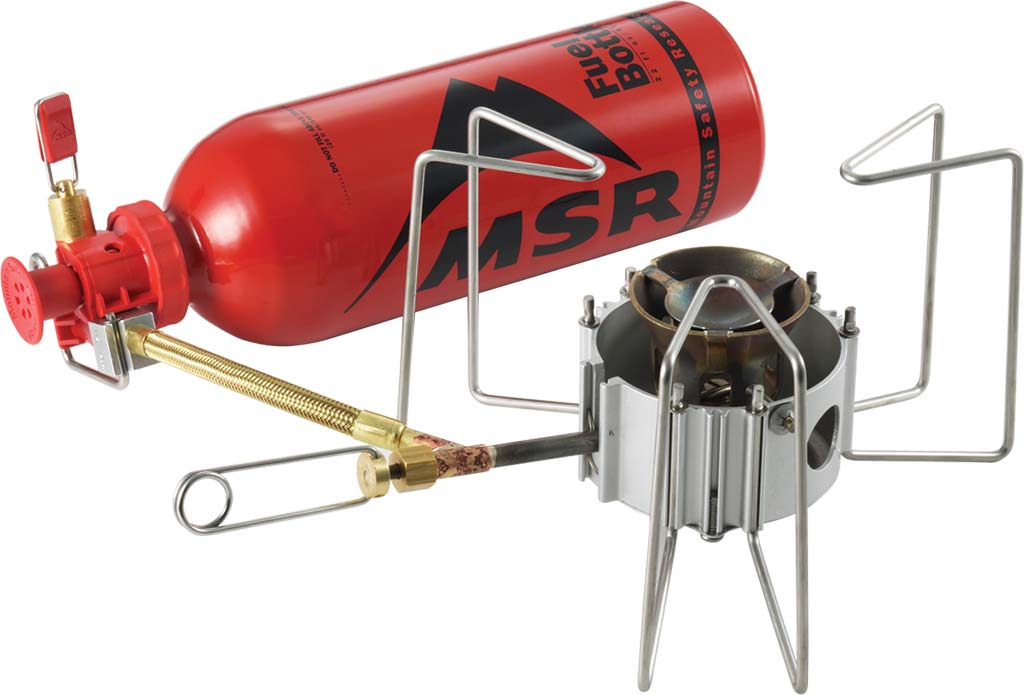
The Dragonfly was launched in 1998 and marketed as an XGK that simmers – the XGK being a full-on nuclear blowtorch choice for serious expeditions. However, having used the Dragonfly on expeditions ranging from climbing Himalayan peaks to crossing deserts, one thing was for sure: it’s no XGK. That said, the ‘Fly’ is a serious contender as a multi-fuel burner with its ability to simmer gently and turn rocks to lava when fully opened up. In use it’s loud – keep your ear plugs handy loud – and it’s easy enough to strip and service on extended trips. The pot stands are stable and wide, the shaker jet self-cleaning system a handy feature for reducing day-to-day fuel residue and spare parts are widely available. Take care with the plastic pump as it’s not the strongest. The Fly comes with a windbreak, a stuff sack, a detailed manual and spare parts.
Top multi-fuel contender
✓✓✓✓
In a line: Easy to service, great performance
PRIMUS ETAPOWER MF
Gas and multi-fuel
1,488g
£145
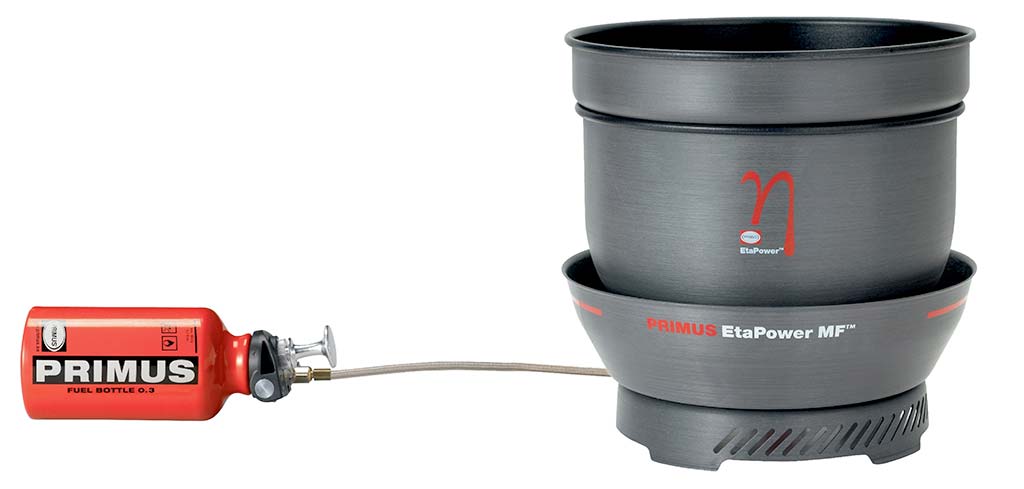
The big story with the Etapower MF (Multi Fuel) is fuel and heat efficiency, and what Primus would like us to call Total Weight Concept. Etapower is a system rather than just a burner and bottle, comprising a stable base plate which holds a detachable multi-fuel burner head (think Trangia), an integral windshield (ditto) and a non stick bowl and pan plus a plastic bowl. The Eta pan is a new one on us, with a unique base featuring raised fi ns for greater heat retention and efficiency. And the system works well, with Primus claiming a system fuel/heat efficiency of 80% as opposed to the usual 40% associated with camping stoves. You can burn diesels and attach a gas canister to the same braided fuel hose. Well made, easy to clean, big enough to cook for two and it all comes packed in a top quality insulated/ protective bag.
Best for travelling with a partner
✓✓✓✓✓
In a line: Versatile, fuel efficient and big enough for two
TRANGIA MULTI FUEL
Multi-fuel
582g
£150
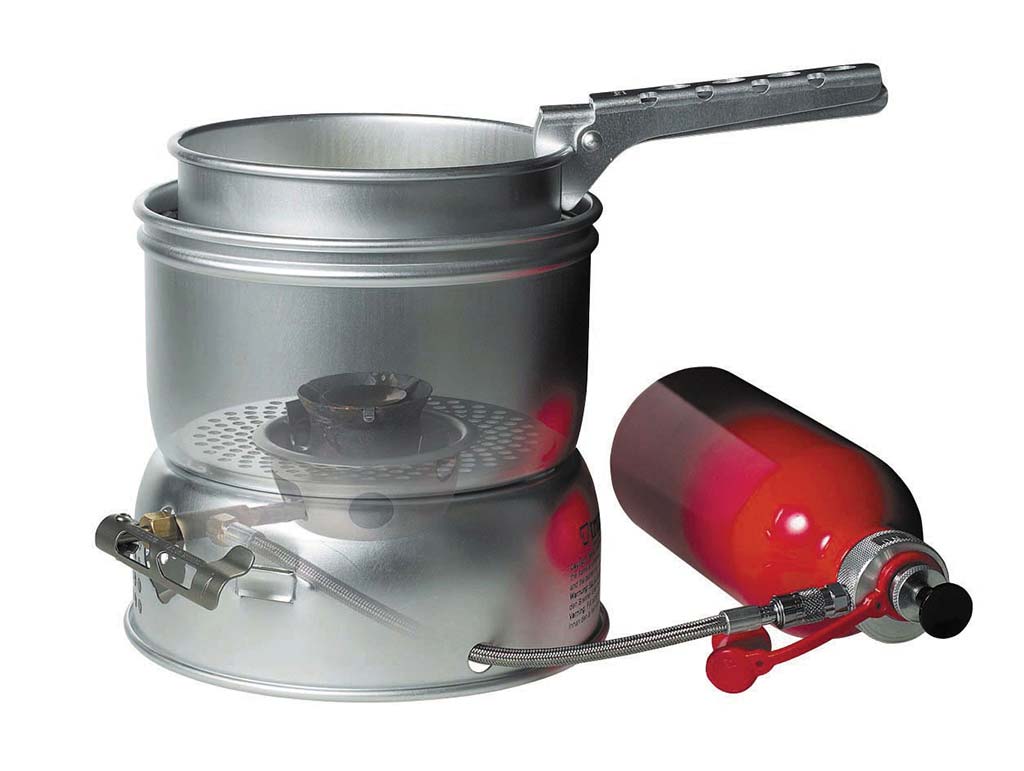
If you already own a Trangia cook set, this multi-fuel burner has your name on it. You get a burner with a steel braided fuel line, a Trangia branded fuel bottle and a nifty little tool that goes under the name of a Magic Combi and is used for dismantling and cleaning the stove. Multi-fuel stoves are designed for travelling in cold conditions and for extended trips in areas where you’re unlikely to find cannister gas. Once you’ve established that the stove works – and this one does, very well – then your next concern is how easy it is to clean and service when travelling (fuels such as diesel and petrol contain additives which clog the workings). The Trangia has a magnet built into the Magic tool which, when moved under the burner, activates a jet cleaning needle to great effect. Spot on.
Best for Trangia groupies
✓✓✓✓✓
In a line: Great performance and easy to clean
VANGO FOLDING GAS STOVE
Gas
210g
£20
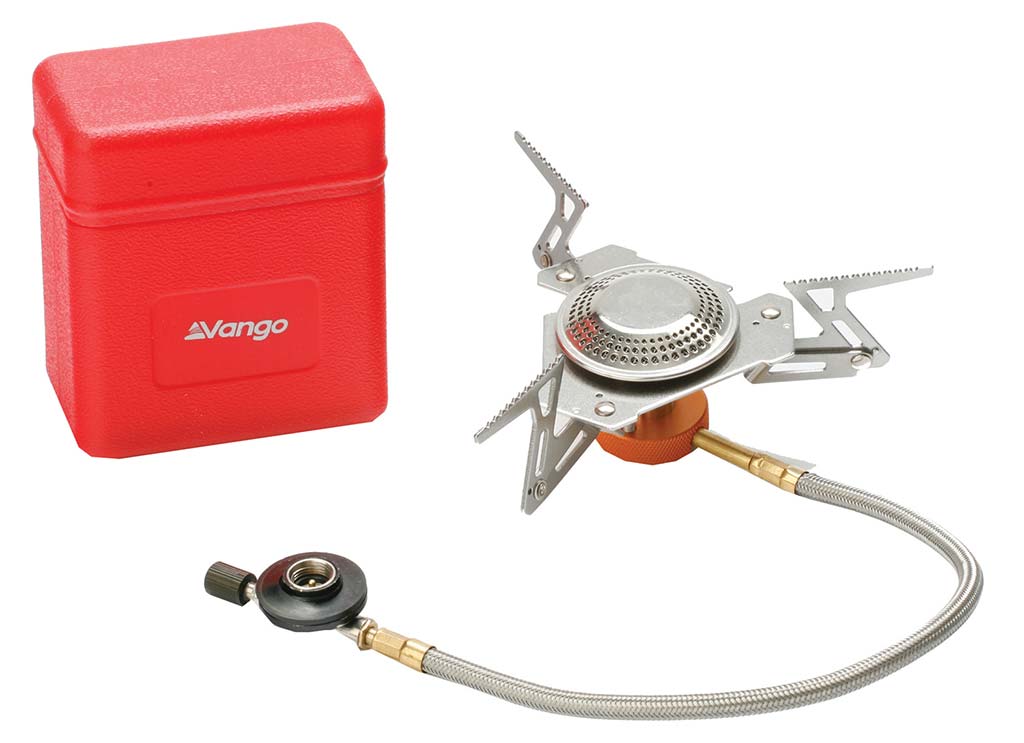
At 210g the Vango’s three times the weight of the lightest gas stoves on test. However, one of the pains associated with ultra lightweight stoves, which screw into the top of a gas cartridge, is that they are inherently unstable due to the high centre of gravity and narrow pot supports. This is an area where the Vango Folding Gas Stove wins every time. This stove has three wide, stable legs which sit directly on the ground and it connects to a gas canister via a 35cm-long fuel hose. The result is a superb level of stability even when loaded with the largest pots and pans. The construction quality’s good and operation’s simple and precise, from a low simmer to a full-on boil. The stove folds away into a neat, hard plastic case that comes as part of the package. The off -the-canister-design also makes a windbreak more effective.
Best budget buy
✓✓✓✓✓
In a line: Great price, great performance, highly recommended
VANGO ULTRALITE GAS STOVE
Gas
71g
£20
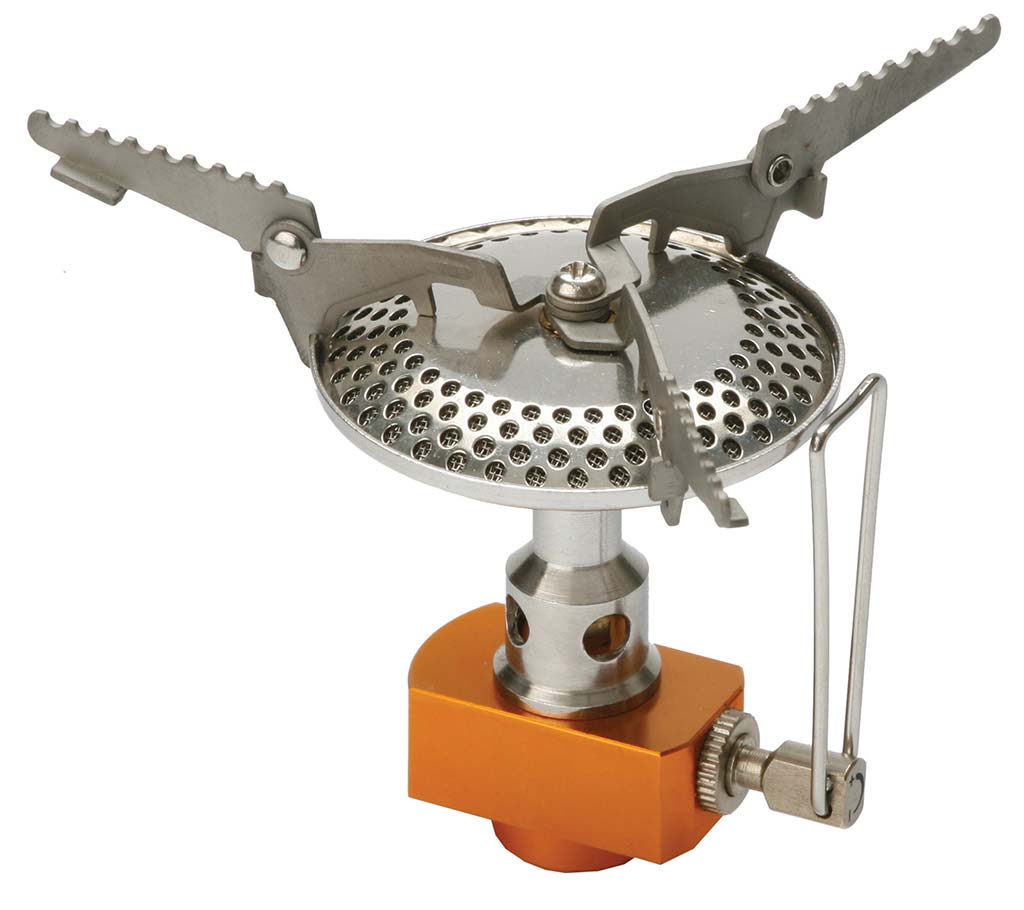
Weighing in at a paltry 71g the Vango Ultralite’s the lightest stove on test, pipping the Coleman F1 Lite by 3g – and every little counts to confirmed gear freaks. So, if packing light is where you get your kicks, look no further than this stove. It folds down smaller than a tennis ball in the supplied mini stuff sack and pumps out a credible performance, boiling a litre of water in three minutes. Priced at a competitive £20 there’s little to fault with this stove other than to say that its compact size, which is its big advantage, is also its weakness when it comes to stability. The folding pot stabilisers are shorter than most and you’ll have to be careful not to let the pans topple. Despite their flimsy look and feel the supports have stood up well under extensive use. A simple design with a compact size that does the job.
Lightest on test
✓✓✓
In a line: For the adventurer with a lightweight fetish
COLEMAN F1 LITE
Gas
74g
£20
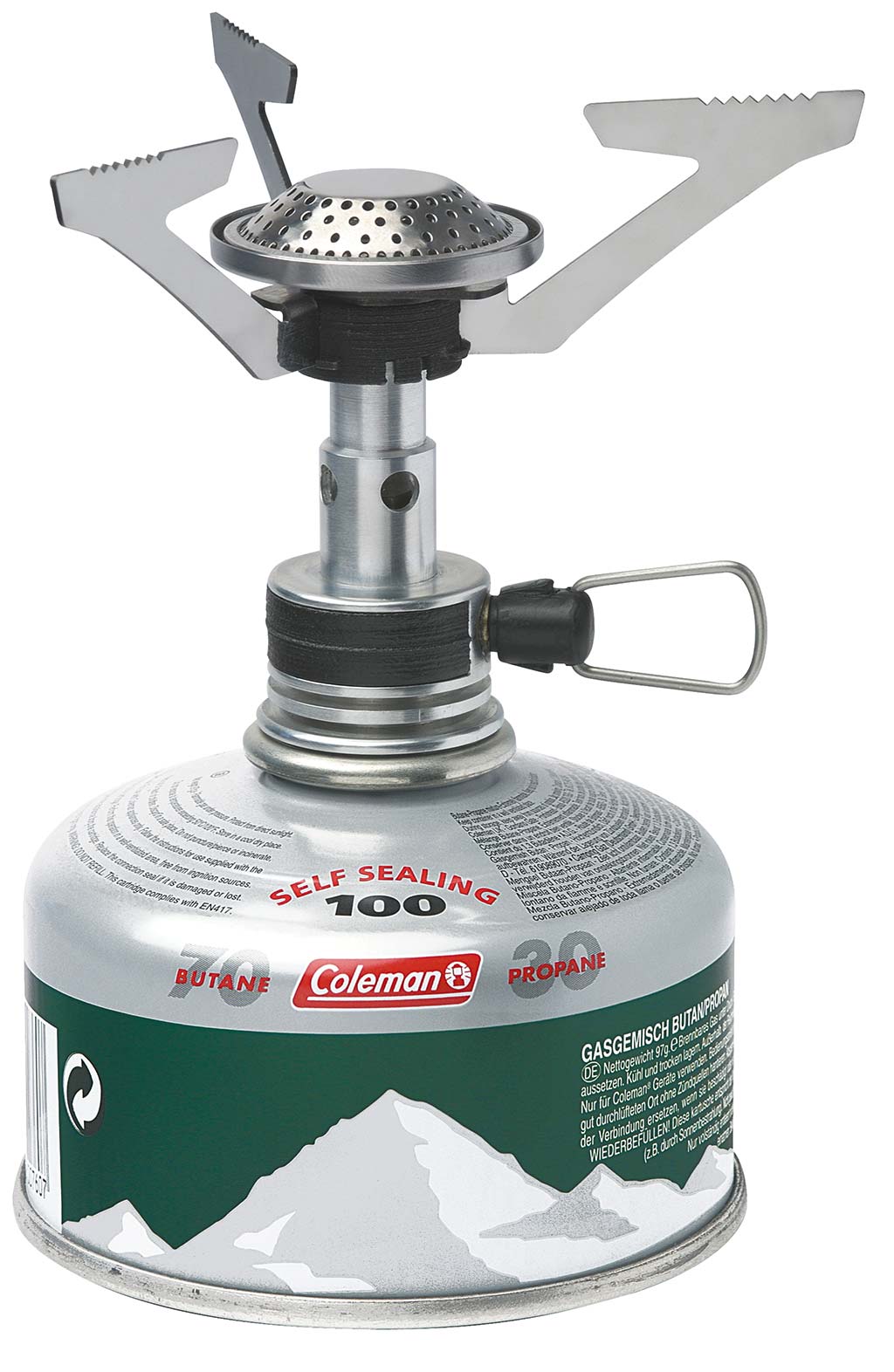
The Coleman F1 competes head on with the Vango Ultralight on price, pack-size and weight, and there’s little to choose between the two. Coleman’s one of the big names in gas camping stoves. We’ve been using and reviewing its products over the years in testing environments and we’ve yet to find a bad one. The F1 comes with a smaller burner head than the Vango but the angle of flame projection spreads the heat to give a similar one-litre boil time. Overall we like this stove but you need to take care of it: the pan support arms are flimsy and bend easily, and there are a couple of plastic parts that are potential weak spots though we’ve not experienced any problems. The F1’s small enough to pack away into the recess on the bottom of a gas canister making it perfect for anyone tight on space.
Great space saver
✓✓✓
In a line: Great stove but needs looking after
MSR POCKET ROCKET
Gas
85g (case 34g extra)
£25
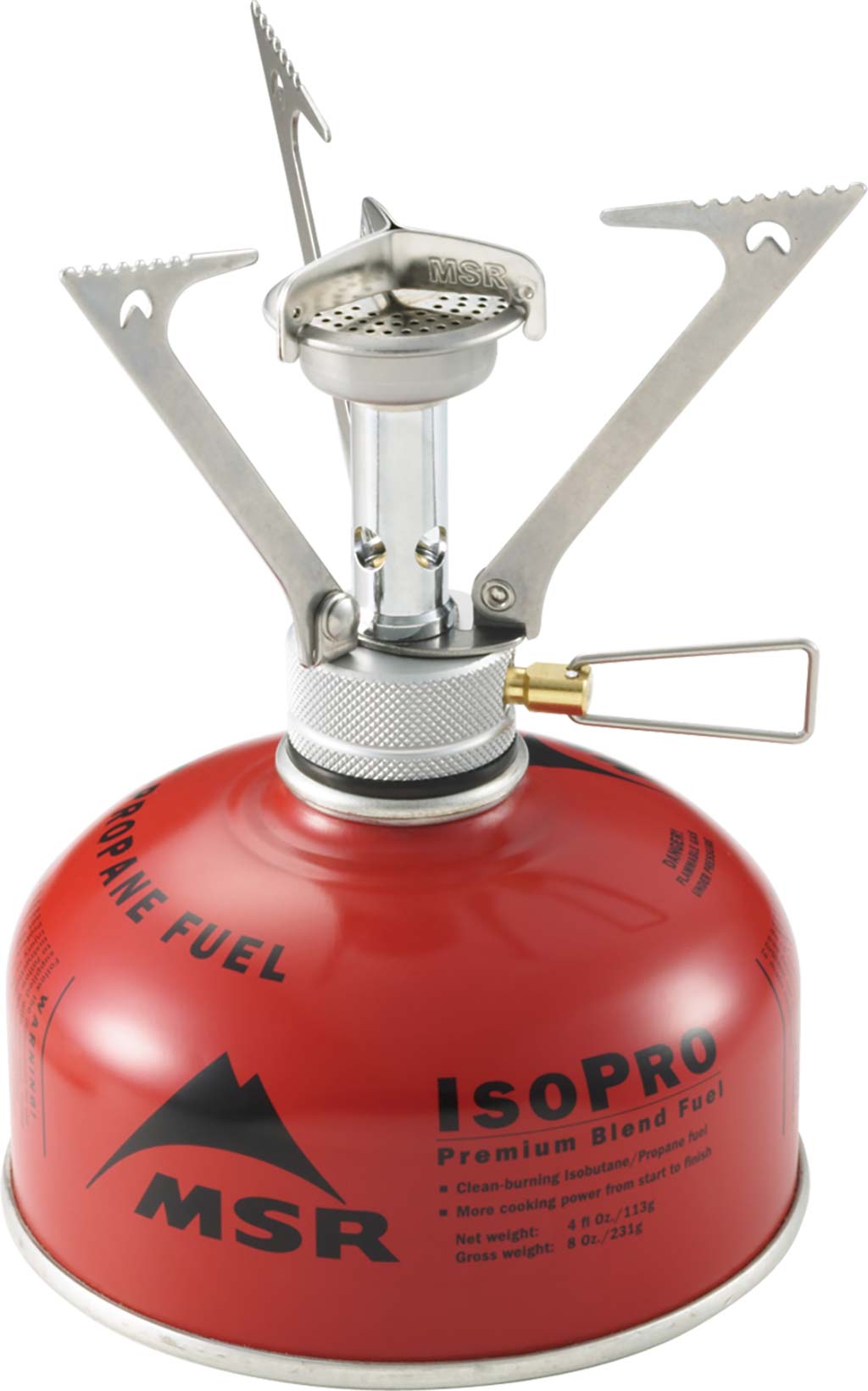
I’ve owned a Pocket Rocket for 10 or so years and it’s stood up well on multi-week wilderness and mountain adventures in Europe and North America. As with all canister-mounted stoves, stability isn’t great and you wouldn’t want to be cooking with big pans or feeding the local bike club. But the construction quality is good: the pan stabilisers are a little wobbly but the serrated edges grip pots well enough. In use it takes about three minutes 20 seconds to boil a litre of water which is slightly longer than the less-expensive Coleman and Vango stoves. When you’re all done and bloated the Pocket Rocket packs away into a Toblerone-shaped hard plastic case that’s smaller than a can of coke. It’s neither the smallest nor the lightest stove on test, but it’s miniscule enough for the difference not to matter.
Good for weight watchers
✓✓✓✓
In a line: A legend in lightweight gas stoves
EDELRID KIRO ST
Gas
84g
£30
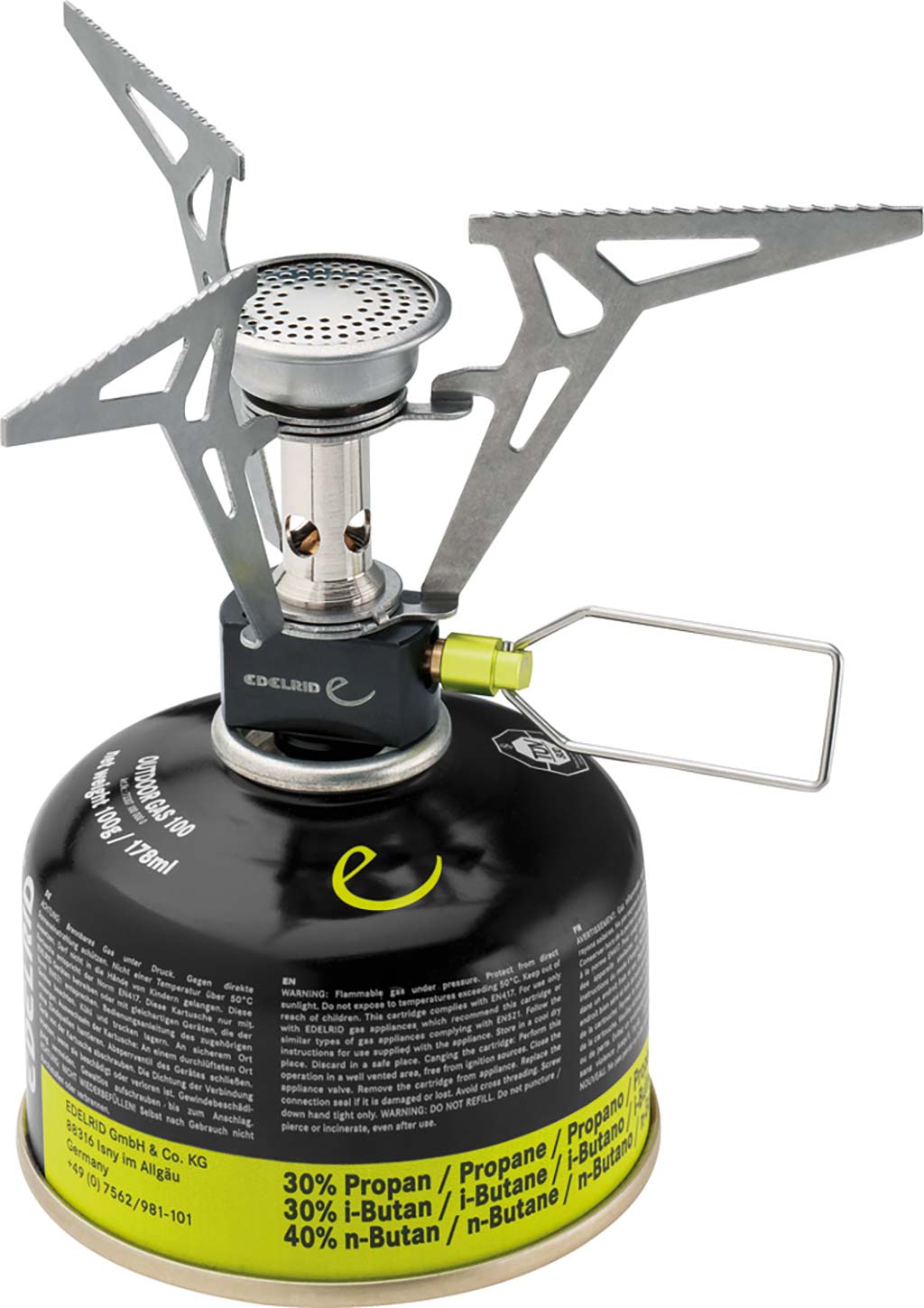
Edelrid is better known to ABR staff for its superb climbing equipment and we’ve used the company’s excellent ropes and harnesses on challenging mountain adventures around the world. First impressions of the Kiro ST are good, with the stove having a look and feel over and above that of similarly priced lightweight burners. For such a lightweight stove the pan supports are wide, offering good stability (for a canister-top stove) and it can handle bigger pots better than most. The serrated edges on the pan supports also grip pots well. The performance is good with a litre boil time of three minutes and the flame control is precise, as you’d expect from a gas burner. With the pan supports folded flat and the control arm tucked away the pack size is small enough not to worry about, and it comes supplied in a pouch.
Good for big pans
✓✓✓✓
In a line: Quality lightweight product with wider pan supports
TRANGIA 27 – 1UL
Gas
824g
£55
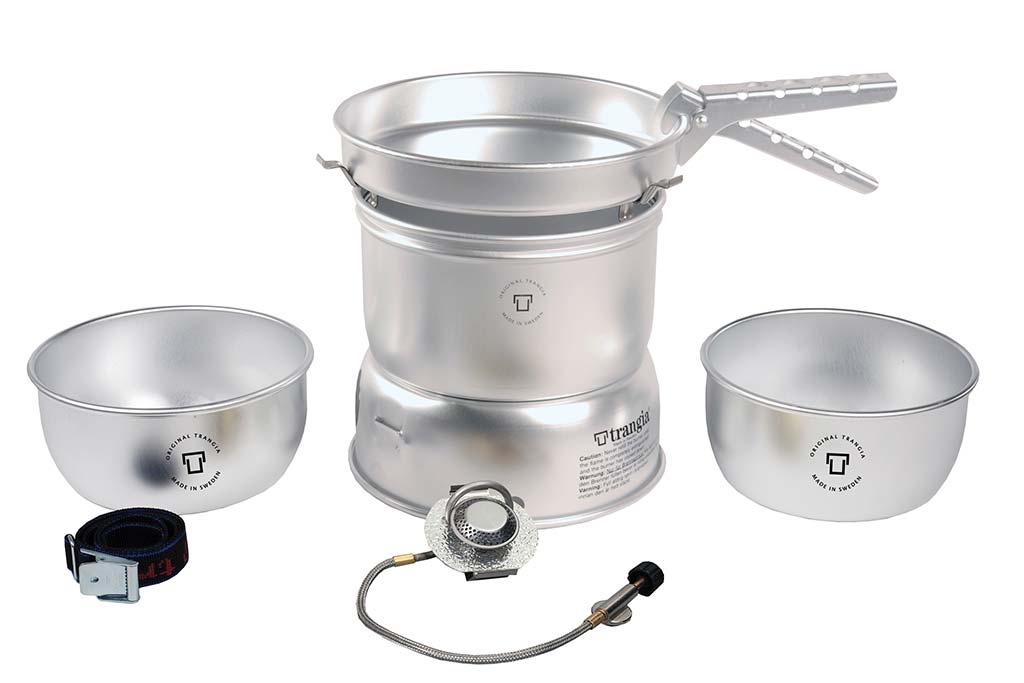
There comes a time in every adventurer’s life when they just have to brew up on a Trangia. These quirky, iconic Scandinavian cook sets are so loved they have a cult following among the outdoor and overland community. Better known as an uncomplicated meths burner they’re also available with a gas burner and that’s what we’ve been looking at here with the 1UL – the 1UL is over 30% lighter than the standard aluminium. Essentially, you get the complete package: windbreak, two pots, frying pan, grab handle, gas burner and an information booklet with suggested recipes. All the components fit together for packing and in use the integral windbreak and pre-warmer make this one of the most heat efficient burners you can buy. The burner head sits in the freestanding base and connects to a gas bottle with a hose, which means it’s very stable and can take bigger pans than others on test.
Best for adventure
✓✓✓✓✓
In a line: Just buy one
EDELRID OPILIO
Gas
186g
£55
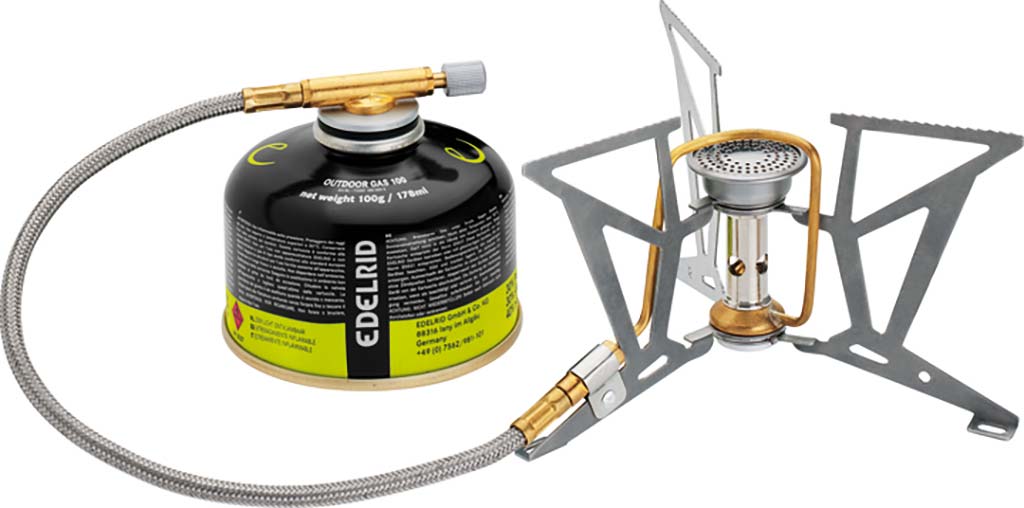
So what have we here? The Opilio’s a freestanding gas burner that connects to a canister through a braided steel hose, meaning it’s stable. With the canister connector a flush fit you can also invert the canister to eke out the last of the gas and there’s better winter temperature performance, plus there’s a pre-heat tube that helps out. The pan supports are wide enough to accommodate a two-litre pan but in use the narrow flame spread means it’ll takes far too long to boil even in a controlled environment. The stove packs down small into a stuff sack and at 186g it’s lightweight for a burner/hose combo but would I pay the extra £35 over the Vango Folding Gas Stove? Maybe not. It’s well made and appears to be robust but I’d want a larger flame spread for faster cooking.
Good for winter
✓✓✓
In a line: Well made and stable
MSR SUPERFLY
Gas
146g
£60
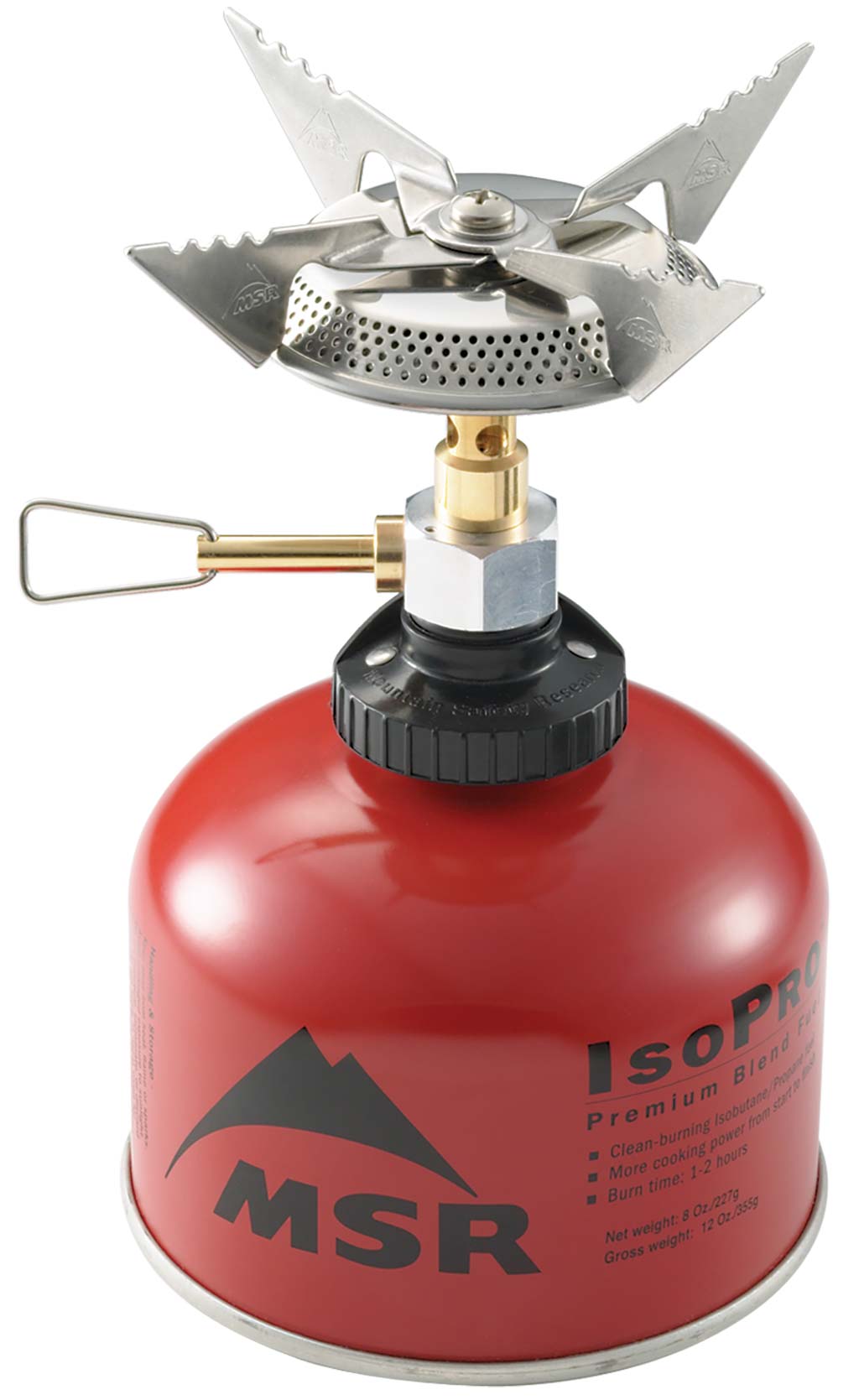
The Superfly’s almost double the weight of a Pocket Rocket and the other ultra lightweight stoves, it costs twice as much and takes up more room in your panniers. So why would you want to buy one? Here’s why… The multi-grab canister mount means it fits just about any canister on the market. The broad flame spread means better heat dissipation, less burned food and it’s capable of cooking in bigger pans for a small group. It’s as stable as a canister-mounted stove’s going to get; the pan supports and grip are above average; the heat control’s excellent and it comes with an auto ignition and a stuff sack. If I were going climbing or mountaineering and space was a premium then maybe I’d look at a smaller stove but when I’ve a couple of panniers and horses to take the load I’d choose the Superfly every day.
Best for luxury
✓✓✓✓✓
In a line: The most versatile canister mounted stove bar none

